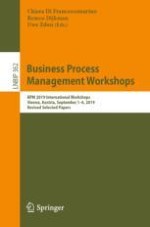This book constitutes revised papers from the twelve International Workshops held at the 17th International Conference on Business Process Management, BPM 2019, in Vienna, Austria, in September 2019:
The third International Workshop on Artificial Intelligence for Business Process Management (AI4BPM)The third International Workshop on Business Processes Meet Internet-of-Things (BP-Meet-IoT)The 15th International Workshop on Business Process Intelligence (BPI)The first International Workshop on Business Process Management in the era of Digital Innovation and Transformation (BPMinDIT)The 12th International Workshop on Social and Human Aspects of Business Process Management (BPMS2)The 7th International Workshop on Declarative, Decision and Hybrid approaches to processes (DEC2H)The second International Workshop on Methods for Interpretation of Industrial Event Logs (MIEL)The first International Workshop on Process Management in Digital Production (PM-DiPro)The second International Workshop on Process-Oriented Data Science for Healthcare (PODS4H)The fourth International Workshop on Process Querying (PQ)The second International Workshop on Security and Privacy-enhanced Business Process Management (SPBP)The first International Workshop on the Value and Quality of Enterprise Modelling (VEnMo)
Each of the workshops discussed research still in progress and focused on aspects of business process management, either a particular technical aspect or a particular application domain. These proceedings present the work that was discussed during the workshops.
